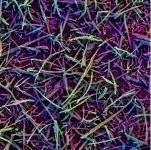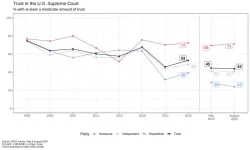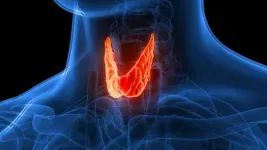(Press-News.org) Groundbreaking Discoveries in Gamma-Ray Emissions from Thunderstorms
In the recent edition of Nature, groundbreaking results about the gamma-ray emissions produced during thunderstorms are presented. Overall, these findings reveal that gamma-ray emission from thunderclouds is much more complex, diverse, and dynamic than previously thought. Understanding these phenomena is crucial to uncovering the secrets of lightning.
Flickering Gamma-Ray Flashes: A New Discovery
Entitled “Flickering Gamma-Ray Flashes, the Missing Link between Gamma Glows and TGFs,” the paper by Østgaard et al. [2024] reports unique observations of a new phenomenon called Flickering Gamma-Ray Flashes (FGFs).
During thunderclouds, two different hard radiation phenomena have so far been known to originate: Terrestrial Gamma-ray Flashes (TGFs) and gamma-ray glows. This third phenomenon, observed and named FGFs by Østgaard et al. [2024] resembles the other two, while at the same time revealing certain characteristics separating FGFs from the others. Most noteworthy may be that FGFs are pulses of gamma-rays not associated with any detectable optical or radio signals.
The Missing Link Found?
«We think that FGFs could be the missing link between TGFs and gamma-ray glows, whose absence has been puzzling the atmospheric electricity community for two decades», says lead author and Professor Nikolai Østgaard at the University of Bergen.
Dynamic Gamma-Ray Emissions in Tropical Thunderclouds
In another study presented in this edition of Nature, Marisaldi et al. [2024] focus on the phenomenon referenced above and known as gamma-ray glows. The paper, entitled «Highly dynamic gamma-ray emissions are common in tropical thunderclouds», shows that contrary to what has been believed until now, tropical thunderclouds over ocean and coastal regions commonly emit gamma rays for hours over areas up to a few thousand square kilometers.
A New Understanding of Gamma-Ray Glows
«The dynamics of gamma-glowing thunderclouds starkly contradicts the former quasi-stationary picture of glows, and resembles that of a huge gamma-glowing boiling pot both in pattern and behavior», says Professor Martino Marisaldi at the University of Bergen.
The ALOFT Campaign
The groundbreaking results presented by Østgaard et al. [2024] and Marisaldi et al. [2024] are based on observations from the ALOFT (Airborne Lightning Observatory for FEGS and TGFs) campaign.
ALOFT, a collaboration between NASA and the University of Bergen, involved flying the NASA ER-2 aircraft from the MacDill Air Force Base, Florida, over tropical thunderstorms around the Gulf of Mexico, Central America, and the Caribbean in the summer of 2023. The payload included lightning detectors, gamma-ray scintillators, and a mix of passive and/ or active microwave sensors. A total of 10 flights were conducted above thunderclouds around Mexico, El Salvador, Nicaragua, and Florida.
The ALOFT campaign was financed by the Research Council of Norway and led by Professor Nikolai Østgaard and Professor Martino Marisaldi from the University of Bergen, Timothy Lang (Marshall Space Flight Center, NASA), and Franzeska Becker (ER-2 Mission Management).
The instrumentation on Board ER-2 during the ALOFT campaign included:
Gamma-ray detectors UIB-BGO (PI: Nikolai Østgaard, UiB) and iStorm (PI: Eric Grove, NRL)
An optical instrument named FEGS (PI: Mason Quick, Marshall Space Flight Center, NASA)
Two electric field sensors known as EFCM (PI: Hugh Christian, University of Alabama, Huntsville) and LIP (PI: Christopher Schultz, Marshall Space Flight Center, NASA)
Four cloud characterization instruments: AMPR (PI: Timothy Lang, Marshall Flight Center, NASA), CRS and EXRAD (PI: Gerry Heymsfield, Goddard Space Flight Center, NASA), and CoSSIR (PI: Rachael Kroodsma, Goddard Space Flight Center, NASA)
The flight campaign was coordinated with ground-based radio observations managed by a large network of collaborators.
END
Missing link found in gamma emission phenomena from thunderclouds
Groundbreaking research reveals new insights into gamma-ray emissions during thunderstorms
2024-10-02
ELSE PRESS RELEASES FROM THIS DATE:
Social media users’ actions, rather than biased policies, could drive differences in platform enforcement
2024-10-02
A new paper, “Differences in misinformation sharing can lead to politically asymmetric sanctions,” published today in Nature suggests that the higher quantity of social media policy enforcement (such as account suspensions) for conservative users could be explained by the higher quantity of misinformation shared by those conservative users — and so does not constitute evidence of inherent biases in the policies from social media companies or in the definition of what constitutes misinformation.
Written by ...
How a bacterium becomes a permanent resident in a fungus
2024-10-02
Endosymbiosis is a fascinating biological phenomenon in which an organism lives inside another. Such an unusual relationship is often beneficial for both parties. Even in our bodies, we find remnants of such cohabitation: mitochondria, the powerhouses of our cells, evolved from an ancient endosymbiosis. Long ago, bacteria entered other cells and stayed. This coexistence laid the foundation for mitochondria and thus the cells of plants, animals, and fungi.
What is still poorly understood, however, is how an endosymbiosis as a lifestyle actually arises. A bacterium that more or less accidentally ...
Study: For long COVID, lithium aspartate at low doses is ineffective, but higher doses may be promising
2024-10-02
BUFFALO, N.Y. — A small University at Buffalo clinical trial has found that at low doses, lithium aspartate is ineffective in treating the fatigue and brain fog that is often a persistent feature of long COVID; however, a supplemental dose-finding study found some evidence that higher doses may be effective.
Published in JAMA Network Open on Oct. 2, the study was led by Thomas J. Guttuso, Jr., MD, professor of neurology in the Jacobs School of Medicine and Biomedical Sciences at UB and a physician with UBMD Neurology.
“It’s a negative study with a positive twist,” Guttuso concludes.
Because ...
Online insomnia treatment can help caregivers get much-needed rest, study suggests
2024-10-02
Providing care for a family member with a disabling illness can be a demanding job that leaves many people unable to sleep, but an online insomnia treatment developed at the University of Virginia School of Medicine can help, new research shows.
Not only did the SHUTi (Sleep Healthy Using the Internet) sleep intervention help caregivers get better rest, it most benefited those shouldering the greatest responsibilities in caring for their loved ones, the researchers found.
The results suggest the online format of the program ...
Attivare licenses Wyss Institute’s immune-modulating biomaterial technology to advance immunotherapies
2024-10-02
Attivare licenses Wyss Institute’s immune-modulating biomaterial technology to advance immunotherapies
The company is developing the biomaterial-based technology to develop novel therapies able to program anti-cancer immunity and prevent infectious diseases
By Benjamin Boettner
(BOSTON) — Today, the Wyss Institute for Biologically Inspired Engineering at Harvard University and Attivare Therapeutics Inc. announced that Attivare has licensed a portfolio of immune-modulating biomaterial technologies from Harvard University that was created at the ...
Regenstrief, Fairbanks researcher among 25 fellows to be inducted into American College of Medical Informatics
2024-10-02
The American College of Medical Informatics (ACMI) has announced that Chris Harle, PhD, of the Indiana University Richard M. Fairbanks School of Public Health and the Regenstrief Institute will be inducted as one of 25 new fellows on November 10 in San Francisco, CA, at ceremonies during the American Medical Informatics Association (AMIA) 2024 Annual Symposium.
ACMI is a college of elected fellows who have made significant and sustained contributions to the field of biomedical informatics. Individuals who have achieved national recognition in the field and are committed to advancing ...
Ontario Institute for Cancer Research funding aims to speed the development of new drugs for some of the most common cancers
2024-10-02
October 2, 2024, TORONTO – The Ontario Institute for Cancer Research (OICR) continues to support Ontario drug discovery research by funding high-quality investigations of new therapies for some of the most prevalent pediatric and adult cancers. These projects are tackling substantial challenges in cancer by increasing the effectiveness and availability of immunotherapies, making cancer more vulnerable to chemotherapy and developing a new drug for one of the deadliest forms of childhood brain cancer.
OICR’s Cancer Therapeutics Innovation Pipeline (CTIP) initiative is supporting three research teams ...
Trust in US Supreme Court continues to sink
2024-10-02
PHILADELPHIA – Driven by political partisanship, public trust in the U.S. Supreme Court has continued a downward slide since the court’s 2022 Dobbs decision overturning the Roe v. Wade ruling that established a constitutional right to abortion, according to a new survey by the Annenberg Public Policy Center (APPC) of the University of Pennsylvania.
More than half of Americans (56%) now disapprove of the Supreme Court, saying they trust it either “a little” or “not at all” to act in the best interest ...
Rice’s Biotech Launch Pad to lead commercialization of bioelectrical implant treatment for obesity, type 2 diabetes
2024-10-02
Rice University is part of a multiuniversity research team that has secured an award of up to $34.9 million from the Advanced Research Projects Agency for Health (ARPA-H) to accelerate the development of a bioelectronic implant designed to improve adherence for obesity and type 2 diabetes (T2D) treatment while reducing development and manufacturing costs.
Rice University’s Biotech Launch Pad will lead the commercialization effort for “Rx On-site Generation Using Electronics” (ROGUE), a self-contained, durable implantable device that houses cells engineered ...
Carnegie Mellon to lead development of implantable cell-based bioelectronic devices for patient-specific treatment and disease monitoring
2024-10-02
PITTSBURGH – A Carnegie Mellon University-led team has secured an award of up to $42 million from the Advanced Research Projects Agency for Health (ARPA-H) to accelerate the development of implantable, cell-based bioelectronic devices that deliver patient-specific therapy and monitor disease status, for conditions like hypo- and hyperthyroidism, in real time. This award is part of the ARPA-H REACT program, which supports the advancement of implantable bioelectronic devices to improve patient management of chronic diseases.
Burak ...
LAST 30 PRESS RELEASES:
Injectable breast ‘implant’ offers alternative to traditional surgeries
Neuroscientists devise formulas to measure multilingualism
New prostate cancer trial seeks to reduce toxicity without sacrificing efficacy
Geometry shapes life
A CRISPR screen reveals many previously unrecognized genes required for brain development and a new neurodevelopmental disorder
Hot flush treatment has anti-breast cancer activity, study finds
Securing AI systems against growing cybersecurity threats
Longest observation of an active solar region
Why nail-biting, procrastination and other self-sabotaging behaviors are rooted in survival instincts
Regional variations in mechanical properties of porcine leptomeninges
Artificial empathy in therapy and healthcare: advancements in interpersonal interaction technologies
Why some brains switch gears more efficiently than others
UVA’s Jundong Li wins ICDM’S 2025 Tao Li Award for data mining, machine learning
UVA’s low-power, high-performance computer power player Mircea Stan earns National Academy of Inventors fellowship
Not playing by the rules: USU researcher explores filamentous algae dynamics in rivers
Do our body clocks influence our risk of dementia?
Anthropologists offer new evidence of bipedalism in long-debated fossil discovery
Safer receipt paper from wood
Dosage-sensitive genes suggest no whole-genome duplications in ancestral angiosperm
First ancient human herpesvirus genomes document their deep history with humans
Why Some Bacteria Survive Antibiotics and How to Stop Them - New study reveals that bacteria can survive antibiotic treatment through two fundamentally different “shutdown modes”
UCLA study links scar healing to dangerous placenta condition
CHANGE-seq-BE finds off-target changes in the genome from base editors
The Journal of Nuclear Medicine Ahead-of-Print Tip Sheet: January 2, 2026
Delayed or absent first dose of measles, mumps, and rubella vaccination
Trends in US preterm birth rates by household income and race and ethnicity
Study identifies potential biomarker linked to progression and brain inflammation in multiple sclerosis
Many mothers in Norway do not show up for postnatal check-ups
Researchers want to find out why quick clay is so unstable
Superradiant spins show teamwork at the quantum scale
[Press-News.org] Missing link found in gamma emission phenomena from thundercloudsGroundbreaking research reveals new insights into gamma-ray emissions during thunderstorms





